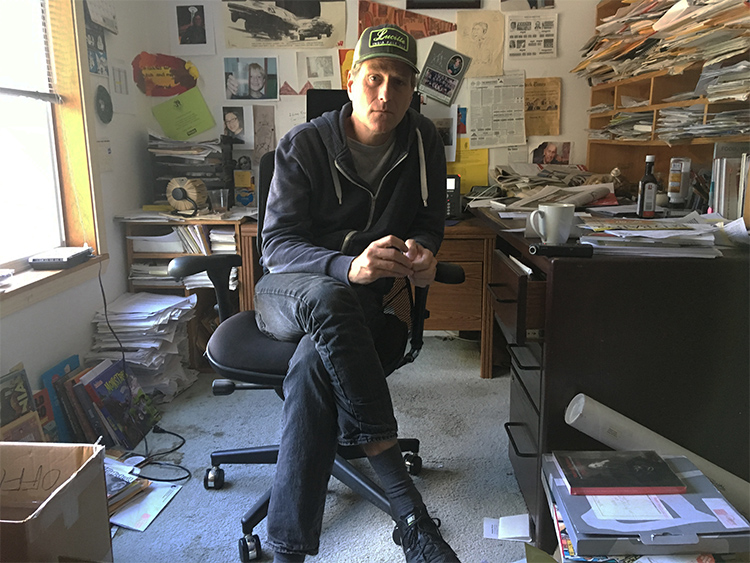Eric Reynolds is one of the most well respected and loved figures in the world of alternative comics. He is loved by cartoonists, loved by fans, loved by booksellers, and loved by journalists like myself. When he was director of marketing and public relations at Fantagraphics Books, Eric facilitated many of the interviews with cartoonists that I conducted during a trip to the US in 1997. Here’s a complete list of the people I met back then, and the people I have been interviewing again for this series. (Visit Lion’s Tooth HERE.)
In my first visit to the Fantagraphics headquarters in Seattle 20-some years ago, I talked to legendary publisher and co-owner Kim Thompson, who sadly passed away in 2013. I came back in 2017, and this time sat down for a conversation with Eric Reynolds, who is now co-publisher at Fantagraphics. A cartoonist himself, Eric was The Comics Journal news editor and played guitar and sang in the band The Action Suits (with Al Columbia, Peter Bagge, and others). Although this conversation is almost three years old, it is a great reflection on comics today and how the industry has evolved—all from an extremely knowledgeable and insightful insider.
This interview excerpt has been edited for clarity. Find the full interview HERE.
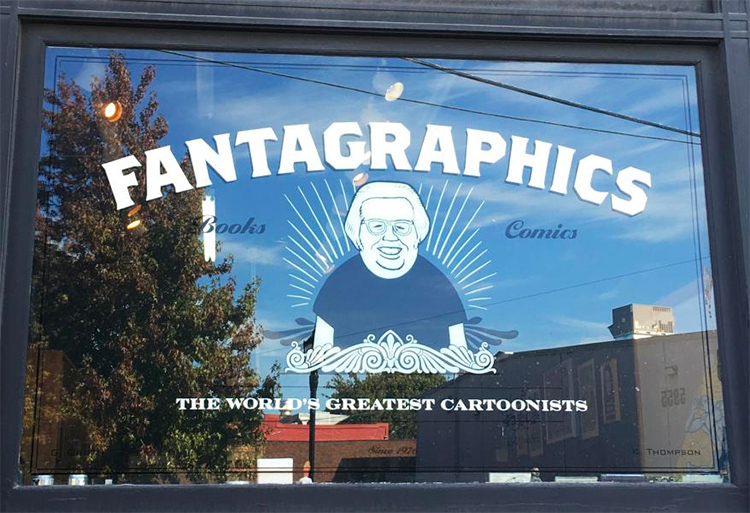
Window of the Fantagraphics store with art by Daniel Clowes.
Cris Siqueira: How did you first get involved with comics?
Eric Reynolds: I was a lifelong comics fan. I never thought I’d work in comics because it didn’t even seem like a legitimate career. I never even thought about it, but I always drew. Long story short, when I got into college, I was studying journalism, but through a strange twist of fate, I ended up interning in Fantagraphics and never leaving, basically.
CS: How old were you when you started?
ER: Here? I had just turned 22. It was my 22nd birthday, literally a couple of days before I started here.
CS: Did you publish your own comic books?
ER: Yes. I did comics all growing up. I drew comics, I copied comics. When I was in college, I was the managing editor of the university paper. Like I said, I was studying journalism, but I was also the staff cartoonist, and did comics strips and editorial cartoons.
CS: Do you do anything with your drawings?
ER: Not really. I’ve gotten to the point in my life where I stopped drawing comics. I’ve been so invested in Fantagraphics that I lost interest in doing my own comics. I still draw a lot. In fact, I draw more now than I have over the past 20 years. The thing I like the most about it is that I don’t do anything with it. It’s just for me and my sketchbook at night. It’s actually been really freeing to not worry about that stuff, because that’s what I do all day long with other Fantagraphics authors. I’m much better off not worrying about that stuff for myself and just doing it for the sake of it.
CS: Not everything has to become a product.
ER: Right. I think when I was in my 20s I didn’t realize that. Everything was like trying to accomplish something, trying to do something. I was always trying to do illustration work, chasing illustration work, chasing other little gigs here and there. Maybe that speaks to how little money there is, how hard it is to make a living in comics…but at a certain point, I realized I didn’t want to do that. I really realized it for myself, I felt like I was doing more good at Fantagraphics than trying to do my own thing.
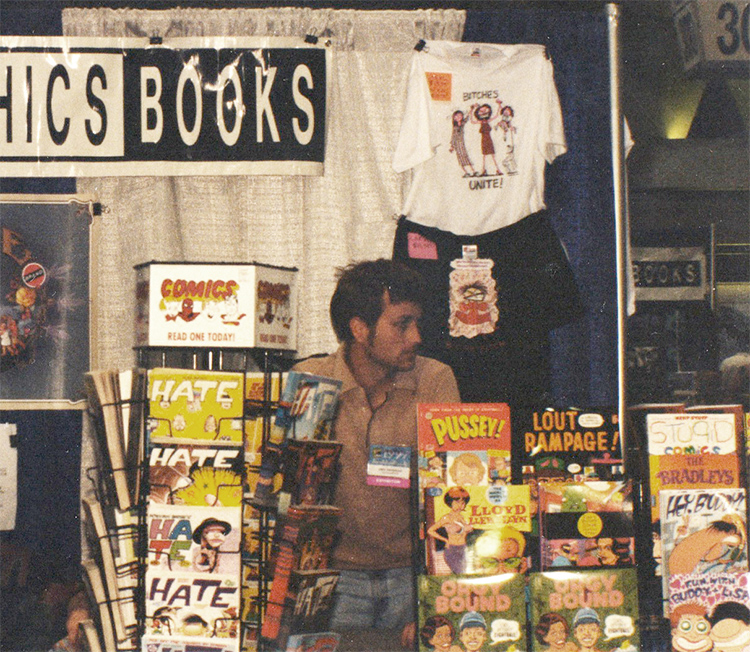
Eric Reynolds in the Fantagraphics booth at the 1997 San Diego Comic Con.
CS: When we first met in 1997, the boom of the ’80s had already passed, but the cartoonists I interviewed seemed very ambitious, and there was a feeling that they could “make it” any minute. How do you feel about what has happened to the industry since then?
ER: I have so many mixed feelings about it. All that stuff about, “Oh, we’re going to make it big.” In a lot of ways it did happen, but in a lot of ways it didn’t. Even someone like Dan [Clowes], who has probably become one of the most successful cartoonists of that generation, he doesn’t have mass, mainstream success. It’s just success. You’re still talking about relatively smaller numbers.
CS: For the longest time it was hard for me to be excited about new comics. Now there’s finally a new generation of cartoonists I like. Simon Hanselmann is probably my favorite.
ER: Yes, Simon is great, I love his work, too. He’s a good writer. I think there’s plenty of really good work being done, and I think Simon’s definitely a great example. Today, I feel like everything positive comes with a caveat. I think there is really great work being done, but I do understand what you’re saying when you said you hadn’t been excited about comics for a long time. I can relate to that. I think the reality is probably somewhere in between, where your lack of enthusiasm is probably justified on some level, but I also think that if you were digging a little deeper, you could have found the good stuff. I certainly experienced that. I go through phases where I’m not super excited by some of what I see in contemporary comics, but sometimes I think that’s me being a little lazy too, and if I look hard enough I can find plenty of really good work.
CS: Is it part of your job to find and publish new people? Do you get submissions?
ER: It’s less so the submissions than just staying engaged with the comics community. I feel like we have a prerogative to be proactive and look for good stuff. I say that because I know how easy it can be to just sit back. I’m working on books nonstop, so I always have a stack of proofreading and a stack of stuff to read. I always have more shit to read with Fantagraphics than I can handle at any one time. So it doesn’t always leave a lot of time to go out and actively search for new comics, but I have to do it. I go through phases where I struggle with it and I tell myself like, “Okay, I’ve got to engage.” I guess that’s the best way to put it.
CS: I feel like I end up going back to the same sources and probably missing out on a lot of good things.
ER: If you know what you want, it’s so much easier to find it, and that’s great. I think I could put on my old man hat and complain about how it’s not as good as it was back then or whatever, but I think the thing that is different about what you just described and that I miss the most is the gatekeepers, the tastemakers that you could trust to steer you in the right direction, even if you didn’t know exactly what you wanted. If you knew that you had a particular taste for a certain kind of music, you could read Maximum Rocknroll and find something that’s in your ball park, even if you don’t like it or whatever. Stuff like Factsheet Five. Even the stores, good independent stores, of which there used to be a lot more.
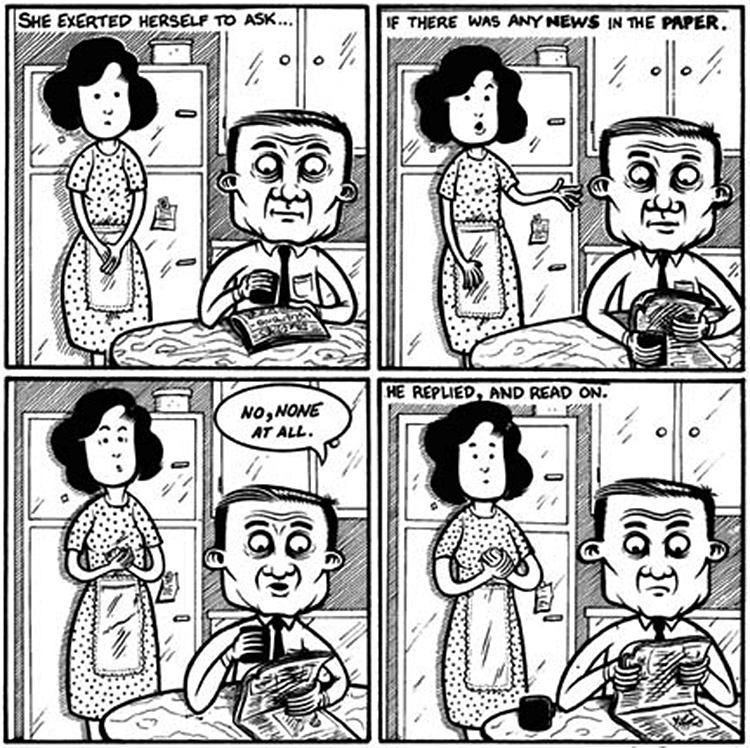
Comic strip by Eric Reynolds for Seattle’s Stranger paper.
I think that’s the part that I miss the most, and I see it at Fantagraphics because we’re publishing just as many books as we ever have, but there’s fewer and fewer places for them to get reviewed and to get written about in a substantial way. I mean, you can get a blog review or something like, “This is the greatest thing I’ve ever read.” That’s cool, but actual good writing, good criticism, whether it be positive or negative, that’s the part that concerns me moving forward. I can really only speak for myself, but most of our engagement these days is with the consumer directly, like social media. Whereas, again, in the ’90s, we were working with these middlemen. You could say that eliminating the middlemen is great, and it’s great that we have direct rapport with our consumers, but I don’t know. Ultimately, I don’t think it’s a healthy thing. It just seems unsustainable. You have all these different companies that are just targeting their own direct consumers. It strikes me as less of a healthy environment.
CS: Are the audiences bigger? Like, is the audience for Love And Rockets, for example, bigger now than it was in the past?
ER: No, I would say that Love And Rockets in its heyday when the market was completely different, and comics across the board were selling a lot more, Love And Rockets probably sold three times what it sells now. I think back in the ’80s, when it was at its peak, it was probably selling between 20,000 and 25,000 copies per issue. Now the books can still sell well over time. The difference then was that the comic book market was much healthier. These days Marvel and DC have comics that sell under 10,000 copies. Thirty years ago in the ’80s, Marvel would cancel a comic that sold under 50,000. Now, 50,000 is a bestseller for them. That whole market has just completely changed.
CS: Like the Black Panther comic book. They got all these renowned writers to write for the series [Ta-Nehisi Coates, Roxanne Gay, Yona Harvey], but they cancelled the comic just as the movie came out.
ER: That makes perfect sense to me. Now you have a movie, you don’t need the comic. The movies do all the stupid things that the comics did, only better. Seven Spider-Man movies came out in the last 20 years. You don’t need any Spider-Man comics.
CS: It’s like evil has won. [laughs]
ER: Yes, I agree with that. Evil has won in so many ways. Like I said, Marvel is selling fewer comics than they ever have, but who are they selling to? The only fans that haven’t abandoned them yet. All the casual fans, they’ve all abandoned them. They’re down to their base. They’re like Donald Trump spouting racist epithets. They are catering to their base. That base doesn’t give a shit about Ta-Nehisi Coates. What’s my point? They’re set up to fail. Marvel’s on the one hand employing these good writers and talented people of color, but throwing them into an environment that’s openly hostile towards that stuff. They don’t give a shit about diversity. They want their fucking Thor comic, and they want Thor to be a blond-haired Adonis, and they want Black Panther to be what they know Black Panther to be.
CS: One step forward and two steps back again.
ER: Yeah. Up until the election [of Donald Trump] I really felt like, “We’re all on the right side of history. We’re moving in the right direction.” That every generation was more tolerant than the previous generation. You look at where we’ve come as a society in 100 years, and it’s pretty fucking awesome. Then this happens, and you just wonder, “What the fuck? Is everything I thought to be true not true? Are we just going to keep going backwards? Is this just an anomaly? Is this temporary? We’ve had it pretty good there for a few years.”
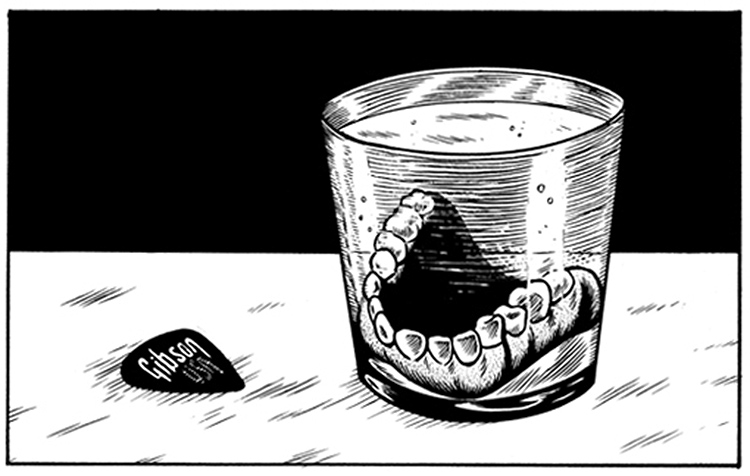
Keith Richards’ Dressing Room by Eric Reynolds.
CS: Going back to comics, it seems that a lot more kids are reading graphic novels now, outside of Marvel and DC.
ER: Part of my point before is that more people are reading comics than ever before, but they’re not buying them in comic book stores. They’re not reading the traditional types of stories that American comics have catered to in the mainstream. They’re reading stuff from Scholastic, like the Raina Telgemeier books, like Jeff Smith’s Bone, manga. Marvel and DC is like fringe culture at this point. The mainstream is books like Sisters and Smile. Younger people are reading comics that they’re not buying in comic book stores. They’re getting them from the libraries, they’re getting them at their schools.
I feel like when I was a kid, you either read comics or you didn’t. If you read comics, you read superhero comics, maybe an Archie comic or something. It was really like a niche thing. If you read them, you were a nerd. That’s not a cliché to the point where when I got into high school, you kept it a secret if you read comics. That’s definitely changed. In my daughter’s elementary school, every kid is reading comics. There was no comics section in my school library growing up. There’s a graphic novel section, and it’s the most popular section in the library. It’s really stuff for everybody. There’s stuff for boys, there’s stuff for girls, there’s stuff for kids who like action, stuff for kids who just like to learn about science, there’s graphic novels about everything. That’s really great.
CS: And people who grow up reading comics are more likely to become artists.
ER: I think that’s true, and I think we’ll have to see over time how it all plays out. I also think the environment is healthier now. My daughter, she could actually enjoy Love And Rockets in a few years. When I was a kid, it was pretty unusual for a girl to go to a comic book store to buy Love And Rockets. Even though most of the girls who read Love And Rockets loved it, but most of them didn’t even know it existed because they wouldn’t go in the stores. I worked in a comic shop for five years in the ’80s. My girlfriend at that time hated coming into the store. I’d like to think that a lot of these younger people who are reading comics that traditionally wouldn’t have in the past could grow up to enjoy Chris Ware, Roz Chast, Alison Bechdel, or Jaime Hernandez. That’s one healthy aspect of things, I think.
Read the full interview HERE.

Eric Reynolds portrait by Pat Moriarty, from a 1995 editorial in The Comics Journal.

